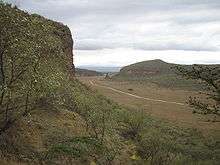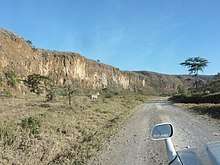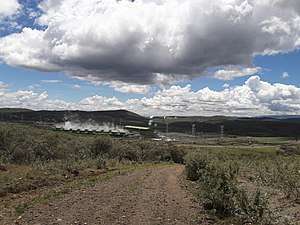Hell's Gate National Park
Hell's Gate National Park lies south of Lake Naivasha in Kenya, north west of Nairobi. Hell's Gate National Park is named after a narrow break in the cliffs, once a tributary of a prehistoric lake that fed early humans in the Rift Valley. It was established in 1984. A small national park, it is known for its wide variety of wildlife and for its scenery.[2] This includes the Fischer's Tower and Central Tower columns and Hell's Gate Gorge. The national park is also home to three geothermal power stations at Olkaria. The park is equipped with three basic campsites and includes a Maasai Cultural Center, providing education about the Maasai tribe's culture and traditions.
| Hell's Gate National Park | |
|---|---|
IUCN category II (national park) | |
 Hell's Gate National Park, December 2014 | |
 Location of Hell's Gate National Park | |
| Location | Rift Valley Province, Kenya |
| Nearest city | Nakuru |
| Coordinates | 0°54′57″S 36°18′48″E |
| Area | 68.25 km2 (26.35 sq mi) |
| Established | 1984[1] |
| Governing body | Kenya Wildlife Service |
History
Hell's Gate National Park is named after a narrow break in the cliffs, once a tributary of a prehistoric lake that fed early humans in the Rift Valley.[3] It received the name "Hell's Gate" by explorers Fisher and Thomson in 1883.[4]
In the early 1900s, Mount Longonot erupted, and ash can still be felt around Hell's Gate.[4] The park was officially established in 1984.[5]
Geography

Hell's Gate National Park covers an area of 68.25 square kilometres (26 sq mi), relatively small by African standards.[6] The park is at 1,900 metres (6,200 ft) above sea level.[1] It is within Nakuru County, near Lake Naivasha and approximately 90 kilometres (56 mi) from Nairobi.[2] The park is located 14 kilometres (9 mi) after the turnoff from the old Nairobi-Naivasha highway, and has a warm and dry climate.[2] Olkaria and Hobley's, two extinct volcanoes located in the park, can be seen as well as obsidian forms from the cool molten lava.[6] Within Hell's Gate is the Hells Gate Gorge, lined with red cliffs which contain two volcanic plugs: Fischer's Tower and Central Tower.[6] Off of Central Tower is a smaller gorge which extends to the south, with a path that descends into hot springs that have rocks hot enough to cause burns, and sulfuric water.[7]
Wildlife
There is a wide variety of wildlife in the national park, though few in number.[6] Examples of little seen wildlife include lions, leopards, and cheetahs.[8] However, the park has historically been an important home for the rare lammergeyer vultures.[2] There are over 103 species of birds in the park, including vultures, Verreaux's eagles, augur buzzard, and swifts.[5] Hyraxes,[7] African buffalo, zebra, eland, hartebeest, Thomson's gazelle, hyena, and baboons are also common.[8] The park is also home to serval and small numbers of klipspringer antelope and Chanler's mountain reedbuck.[4]
Tourism

The park is popular due to its close proximity to Nairobi and lowered park fees compared to other National Parks.[6] Hiking, bicycling, motorcycling and even camping are encouraged within the park,[6] one of only two Kenyan national parks where this is allowed.[4] The Daily Nation praised the mountain climbing in Hell's Gate as "thrilling." It also recommended the Joy Adamson's Centre and boating on Lake Naivasha.[9] A Maasai Cultural Center provides education about the Maasai tribe's culture and traditions.[7]
The park is equipped with three basic campsites, camping is safe in the park even though there are no guns or fencing between you and wildlife.[2] There are also several lodges around Naivasha Lake, popular among tourists for watersports, bird and game viewing in private ranches and walks along Crescent Island, Crater Lake, and Mt. Longonot.[4]
The main setting of the 1994 film, The Lion King is heavily modeled after the park, where several lead crew members of the film went to the park to study and gain an appreciation of the environment for the film.[10]
The 2003 film Lara Croft: Tomb Raider – The Cradle of Life was shot on location in this park.[11]

Olkaria Geothermal Power Station
The comprehensive Olkaria Geothermal Station, the first of its kind in Africa, was established in 1981 and generates geothermal power underneath Hell's Gate from the area's hot springs and geysers.[3] Three more geothermal stations were added after 2000: Olkaria II, Olkaria III and Olkaria IV. Construction of the 140MW Olkaria V commenced in 2017 and the plant came online in 2019.[12] As of 2019, a significant part of the Hell's Gate National Park has turned into an industrial area, with many pipelines, power plants and busy tarmac roads.
References
- World Database on Protected Areas – Hell's Gate National Park
Documentation[create]
- "Hell's Gate National Park". Kenya Wildlife Service. Archived from the original on 2 February 2010. Retrieved 28 December 2009.
- Keeble, Jim (2 May 2008). "Kenya: Nature red in tooth and sauce". The Telegraph. Retrieved 13 June 2008.
- "Safari in Kenya – Hell's Gate National Park". Webkenya. Retrieved 17 June 2008.
- "The Living Africa: National Parks – Kenya – Hell's Gate National Park". library.thinkquest.org. Archived from the original on 6 May 2008. Retrieved 8 June 2008.
- Hodd, Michael (2002). East Africa Handbook: The Travel Guide. Footprint Travel Guides. p. 152. ISBN 1-900949-65-2.
- Hodd, 153.
- Trillo, Richard; Okigbo Ojukwu; Daniel Jacobs; Doug Paterson (2002). The Rough Guide to Kenya. Rough Guides. pp. 243–244. ISBN 1-85828-859-2.
- Njuguna, Michael. "Kenya: Sh31m Airstrip Set to Uplift Growth of Tourism in Region". The Daily Nation. AllAfrica. Retrieved 24 January 2009.
- http://www.bbc.com/travel/feature/20130212-safari-in-kenya-without-four-wheels/2
- http://owaahh.com/why-these-4-famous-movies-werent-shot-in-kenya/
- Reuters (31 July 2019). "KenGen's latest geothermal plant adds 79 MW to grid". Standard Digital. Nairobi. Retrieved 31 July 2019.
External links
| Wikivoyage has a travel guide for Hell's Gate National Park. |
| Wikimedia Commons has media related to Hell's Gate National Park. |